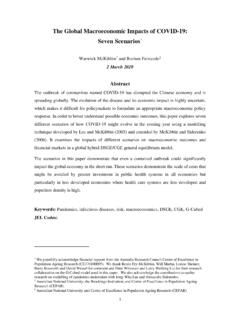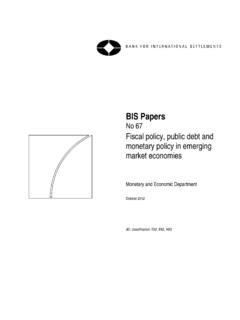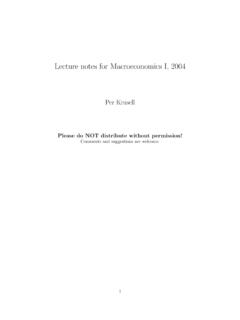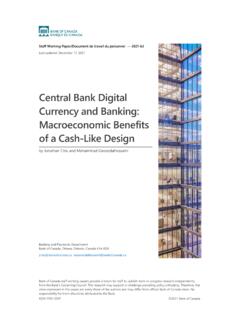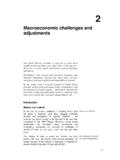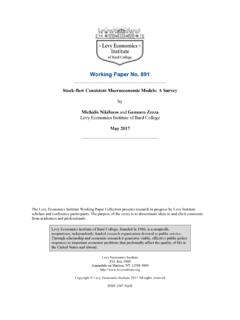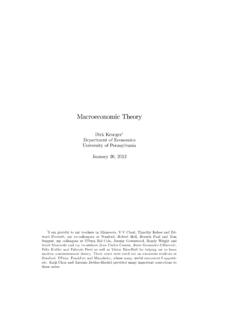Transcription of MACROECONOMIC IMPLICATIONS OF COVID-19
1 NBER WORKING PAPER SERIESMACROECONOMIC IMPLICATIONS OF COVID-19 :CAN NEGATIVE SUPPLY SHOCKS CAUSE DEMAND SHORTAGES?Veronica GuerrieriGuido LorenzoniLudwig StraubIv n WerningWorking Paper 26918 BUREAU OF ECONOMIC RESEARCH1050 Massachusetts AvenueCambridge, MA 02138 April 2020I do not have any conflict of interest or financial relationship that would bear on the research in this paper. The views expressed herein are those of the authors and do not necessarily reflect the views of the National Bureau of Economic working papers are circulated for discussion and comment purposes. They have not been peer-reviewed or been subject to the review by the NBER Board of Directors that accompanies official NBER publications.
2 2020 by Veronica Guerrieri, Guido Lorenzoni, Ludwig Straub, and Iv n Werning. All rights reserved. Short sections of text, not to exceed two paragraphs, may be quoted without explicit permission provided that full credit, including notice, is given to the IMPLICATIONS of COVID-19 : Can Negative Supply Shocks Cause DemandShortages?Veronica Guerrieri, Guido Lorenzoni, Ludwig Straub, and Iv n WerningNBER Working Paper No. 26918 April 2020 JEL No. E21,E32,E60,I18 ABSTRACTWe present a theory of Keynesian supply shocks: supply shocks that trigger changes in aggregate demand larger than the shocks themselves.
3 We argue that the economic shocks associated to the COVID-19 epidemic shutdowns, layoffs, and firm exits may have this feature. In one-sector economies supply shocks are never Keynesian. We show that this is a general result that extend to economies with incomplete markets and liquidity constrained consumers. In economies with multiple sectors Keynesian supply shocks are possible, under some conditions. A 50% shock that hits all sectors is not the same as a 100% shock that hits half the economy. Incomplete markets make the conditions for Keynesian supply shocks more likely to be met.
4 Firm exit and job destruction can amplify the initial effect, aggravating the recession. We discuss the effects of various policies. Standard fiscal stimulus can be less effective than usual because the fact that some sectors are shut down mutes the Keynesian multiplier feedback. Monetary policy , as long as it is unimpeded by the zero lower bound, can have magnified effects, by preventing firm exits. Turning to optimal policy , closing down contact-intensive sectors and providing full insurance payments to affected workers can achieve the first-best allocation, despite the lower per-dollar potency of fiscal GuerrieriUniversity of ChicagoBooth School of Business5807 South Woodlawn AvenueChicago, IL 60637and LorenzoniDepartment of EconomicsNorthwestern University2211 Campus DrEvanston, IL 60208and StraubDepartment of EconomicsHarvard UniversityLittauer 211 Cambridge, MA 02139and n WerningDepartment of Economics, E52-536 MIT50 Memorial DriveCambridge.
5 MA 02142and IntroductionJean-Baptiste Say is famously misquoted for stating the Law supply creates its owndemand. In this paper, we introduce a concept that might be accurately portrayed as supply creates its ownexcessdemand . Namely, a negative supply shock can trigger ademand shortage that leads to a contraction in output and employment larger than thesupply shock itself. We call supply shocks with these propertiesKeynesian supply negative supply shocks, such as those caused by a pandemic, reduce outputand employment. As dire as they may be, supply shock recessions are partly an efficientresponse, since output and employment should certainly fall.
6 However, can a supply shockinduce too sharp a fall in output and employment, going beyond the efficient response?Can it lead to a drop in output and employment for sectors that are not directly affected byshutdowns? Relatedly, could this process produce an anemic recovery or is a V-shapedrecession assured?These are the questions we seek to address in this paper. They are also the questionsbehind recent debates over monetary and fiscal policy responses to the COVID-19 epi-demic and the ensuing economic fallout. We also examine the logic behind these class ofstabilization simple perspective on the effects of COVID-19 , casts the issue as one of aggregatesupply versus aggregate demand, whether the shock to one side is greater than the have expressed skepticism that any demand stimulus is warranted in response towhat is essentially a supply shock, and argue that the economic response should be purelyframed in terms of social insurance.
7 Others have expressed the belief that the pandemicshock can cause output losses larger than efficient. For example,Gourinchas(2020) hasargued for macro measures aimed at flattening the recession curve. The debate illustratesthat a discussion focused on demand versus supply opens up many possibilities, but leavesmany questions unanswered. What forces would induce demand to contract more thansupply?The perspective we offer here is different and based on the notion that supply anddemand forces are intertwined: demand is endogenous and affected by the supply shockand other features of the economy. Our analysis uncovers features of the economy thatmatter and the mechanisms by which forces acting on the supply side end up affectingthe demand side as well.
8 The basic intuition is simple: when workers lose their income,due to the shock, they reduce their spending, causing a contraction in demand. However,the question is whether this mechanism is strong enough to cause an overall shortfall 1:How negative supply shocks can lead to demand shortages Case with equal inter- and intra-temporal elasticities (a)Before the shocksector1sector2sector1workerssector2 workersincomeincome(b)Representative agentsector1shockedsector2unaffectedsect or1workerssector2workersincome(c)Incompl ete marketssector1shockedsector2bustsector1w orkerssector2workersincomeFirst, we show that in one-sector economies the answer is negative: the drop in supplydominates.
9 The result is well-known in a representative agent economy. Less obviously, weshow that it holds true in richer incomplete market models that allow for heterogeneousagents, uninsurable income risk and liquidity constraints, creating differences in marginalpropensities to consume (MPC). In these models, a mechanism from income loss to lowerdemand is present, but although it makes the drop in aggregate demand larger than in therepresentative agent case, the drop is still smaller than the drop in output due to the supplyshock. Intuitively, the MPCs of people losing their income may be large, but is boundedabove at one, which implies that their drop in consumption is always a dampened versionof their income then turn to economies with multiple sectors.
10 When shocks are concentrated incertain sectors, as they are during a shutdown in response to an epidemic, there is greaterscope for total spending to contract. The fact that some goods are no longer availablemakes it less attractive to spend overall. An interpretation is that the shutdown increasesthe shadow price of the goods in the affected sectors, making total current consumptionmore expensive and thus discouraging it. On the other hand, the unavailability of somesectors s goods can shift spending towards the other sectors, through a substitution or not full employment is maintained in the sectors not directly affected by theshutodwn depends on the relative strength of these two show that a contraction in employment in unaffected sectors is possible in a rep-resentative agent setting when the intertemporal elasticity of substitution is sufficiently3high and the elasticity of substitution across sectors is not too alternative intu-ition is that under these conditions the two goods are Hicks complements.










